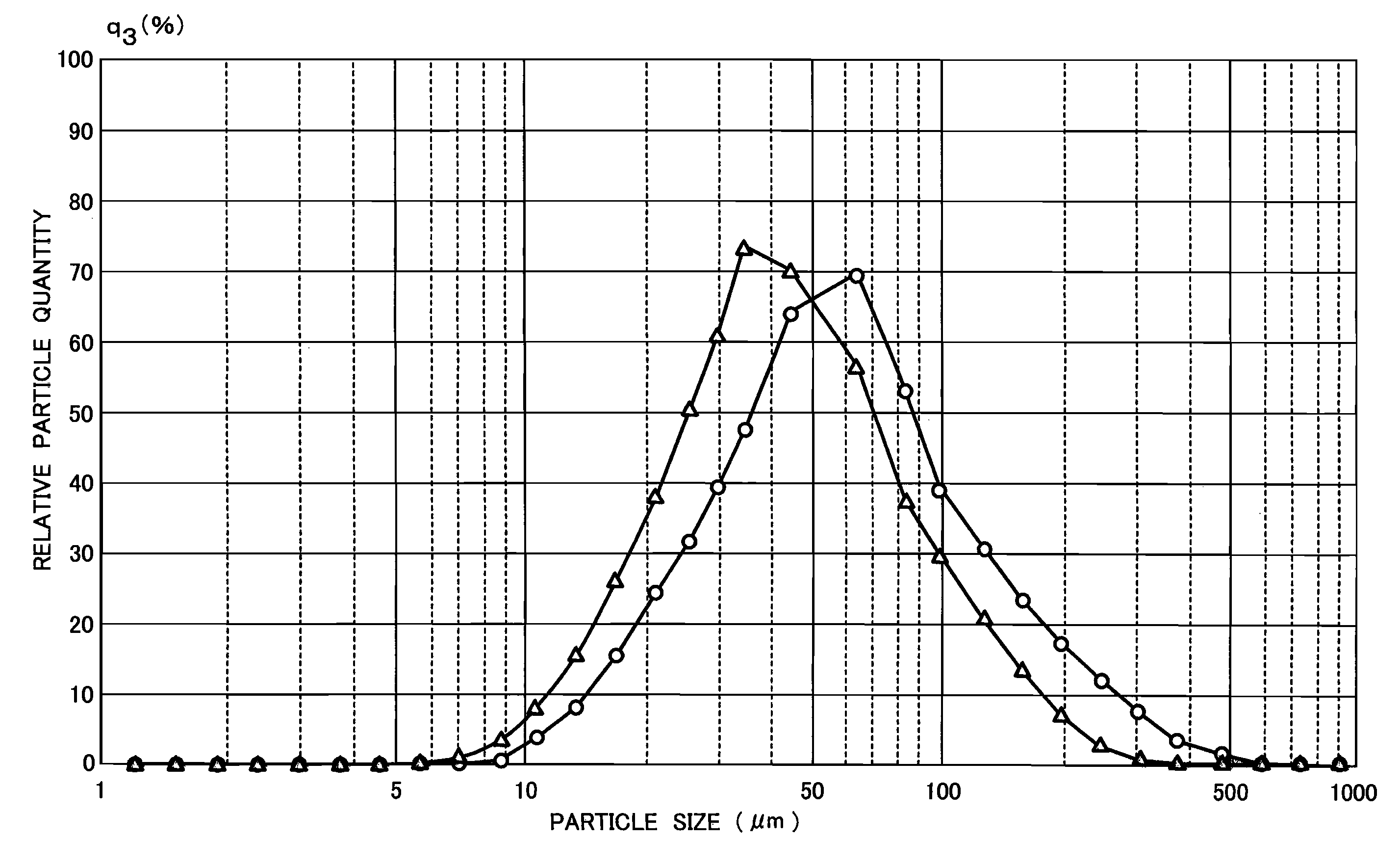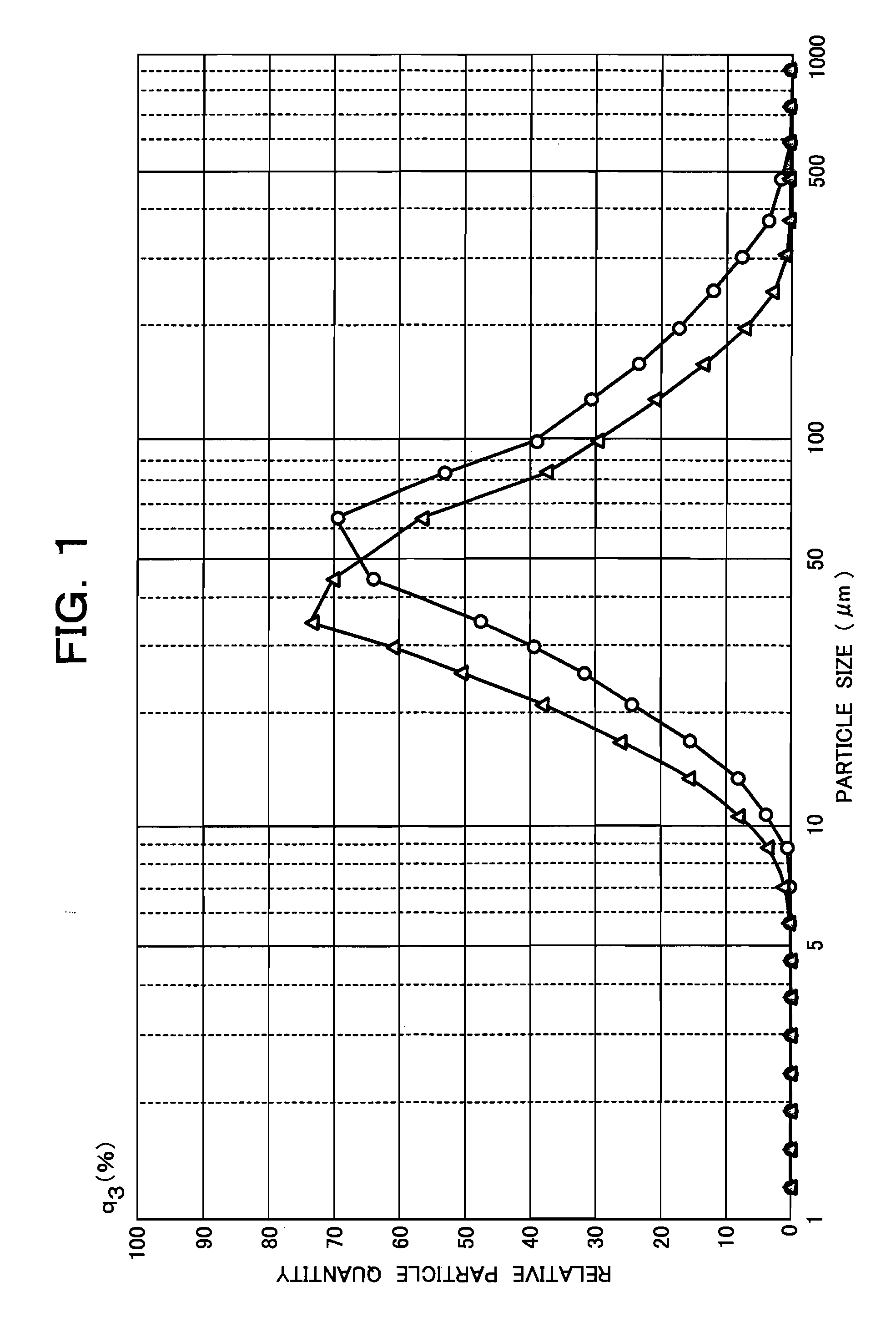Exothermic agent
- Summary
- Abstract
- Description
- Claims
- Application Information
AI Technical Summary
Benefits of technology
Problems solved by technology
Method used
Image
Examples
example 1
[0117]One gram of an aluminum powder having the aforementioned type 1 of particle size distribution was uniformly mixed with 2 g of an aluminum powder having the aforementioned type 2 of particle size distribution. The overall particle size distribution of the resulting mixed aluminum powder was measured with an automatic particle size analyzer of Shimadzu Corporation [SALD-3100 (SALD-3100-WJAl:Vl:00)] and the relative particle quantity (%) versus particle size (μm) profile is shown by -Δ- in FIG. 1. The 1:2 mixed aluminum powder of interest had a median diameter of 43.046, a modal diameter of 41.081, a mean value of 43.302, a standard deviation of 0.285, a 10.0% D of 18.522, a 50.0% D of 43.046, and a 90.0% D of 104.515.
example 2
[0121]Ten grams of an exothermic agent consisting of 6.950 g of a mixed aluminum powder consisting of 2.317 g of type 1 aluminum powder and 4.634 g of type 2 aluminum powder (the mass of type 1 aluminum powder to the mass of type 2 aluminum powder=1:2, accounting for 69.5% of the mass of the exothermic agent) and 3.05 g of calcium oxide (accounting for 30.5% of the mass of the exothermic agent) was packed into a nonwoven fabric bag measuring 63 mm (width)×60 mm (length)×5 mm (thickness), placed on the bottom of the above-described reaction vessel for calorimeter for use with 10 g-20 g, closed with the lid, injected with 20 mL of reaction water through the water injection pipe, whereby an exothermic reaction was caused to generate steam; the change in the temperature of the steam that occurred from zero to 600 seconds was measured with the automatic temperature measuring apparatus and recorded graphically. The result is shown in FIG. 2 by a solid line. The alternate long and short da...
example 3
[0127]Ten grams of an exothermic agent consisting of 6.05 g of a mixed aluminum powder consisting of 2.017 g of type 1 aluminum powder and 4.033 g of type 2 aluminum powder (the mass of type 1 aluminum powder to the mass of type 2 aluminum powder=1:2, accounting for 60.5% of the mass of the exothermic agent) and 3.95 of calcium oxide (accounting for 39.5% of the mass of the exothermic agent) were packed into a nonwoven fabric bag measuring 63 mm (width)×60 mm (length)×5 mm (thickness) and the change in the temperature of the steam that was generated by the same technique as in Example 2 was measured with the automatic temperature measuring apparatus and recorded graphically. The result is shown in FIG. 3 by a solid line. The alternate long and short dash line in FIG. 3 extending between 20-25° C. refers to room temperature.
PUM
 Login to View More
Login to View More Abstract
Description
Claims
Application Information
 Login to View More
Login to View More - R&D Engineer
- R&D Manager
- IP Professional
- Industry Leading Data Capabilities
- Powerful AI technology
- Patent DNA Extraction
Browse by: Latest US Patents, China's latest patents, Technical Efficacy Thesaurus, Application Domain, Technology Topic, Popular Technical Reports.
© 2024 PatSnap. All rights reserved.Legal|Privacy policy|Modern Slavery Act Transparency Statement|Sitemap|About US| Contact US: help@patsnap.com










